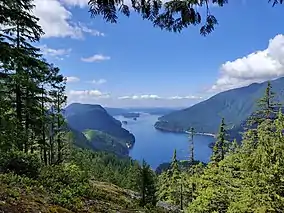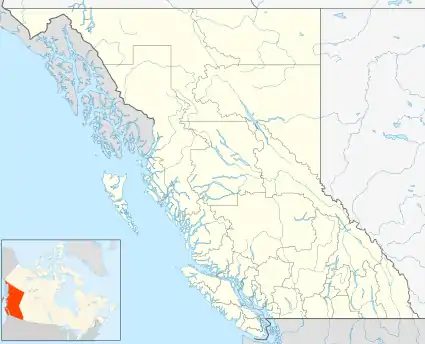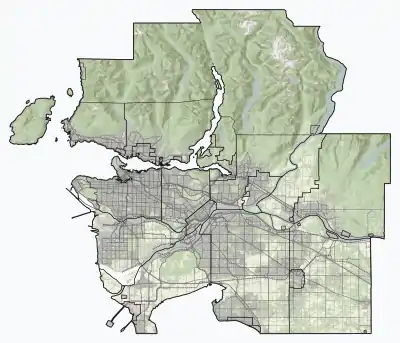Say Nuth Khaw Yum Provincial Park
Say Nuth Khaw Yum Provincial Park, also known as Indian Arm Park, is a provincial park located in the Lower Mainland of British Columbia, Canada.[2] The park was established on July 13, 1995 by BC Parks to protect the forested mountain terrain of Indian Arm.[3]
| Say Nuth Khaw Yum Provincial Park | |
|---|---|
| Indian Arm Park | |
IUCN category II (national park)[1] | |
 A southward view of Indian Arm, taken along the Dilly Dally Loop trail. | |
 Location in British Columbia  Location in Metro Vancouver | |
| Location | Metro Vancouver, British Columbia, Canada |
| Nearest city | North Vancouver |
| Coordinates | 49°26′0″N 122°52′0″W |
| Area | 6,689 ha (25.83 sq mi) |
| Established | July 13, 1995 |
| Governing body | BC Parks |
| Website | Say Nuth Khaw Yum Provincial Park |
History
In 1998, a cooperative park management agreement was signed between BC Parks and the Tsleil-Waututh First Nation.[3]
In February 2010, the park name was changed from Indian Arm Provincial Park to Say Nuth Khaw Yum Provincial Park as part of a second cooperative park management agreement between BC Parks and the Tsleil-Waututh First Nation.[4] Say Nuth Khaw Yum means "Serpent’s Land" in Halkomelem, the traditional language of the Tsleil-Waututh First Nation.[3]
Geography
Say Nuth Khaw Yum Park covers 6,689 hectares (16,530 acres) of mountainous terrain surrounding Indian Arm, an 18 kilometre long fjord that extends north from Burrard Inlet. These lands are part of the traditional territory of the Tsleil-Waututh people who have inhabited the area since time immemorial.[3]
The southeastern corner of the park surrounds most of Buntzen Lake, a small reservoir managed by BC Hydro.
This park also contains a number of significant archaeological sites.[3]
Activities
.jpg.webp)
The park's close proximity to the Greater Vancouver metropolitan area makes it a popular destination for recreation. Popular activities include hiking, camping, kayaking, and scuba diving.[3]
The southeastern corner of the park features a well-developed trail system, most of which are rated as moderately difficult.[5]
See also
References
- "Protected Planet | Indian Arm Park". Protected Planet. Retrieved 2020-10-18.
- "Say Nuth Khaw Yum Park". apps.gov.bc.ca. Retrieved 2020-10-18.
- Environment, Ministry of. "Say Nuth Khaw Yum Provincial Park [aka Indian Arm Park] - BC Parks". bcparks.ca. Retrieved 2020-10-18.
- "Park Management Plan: Say Nuth Khaw Yum / Indian Arm Provincial Park" (PDF). env.gov.bc.ca. February 2010. Retrieved 2010-10-17.
- Environment, Ministry of. "Ministry of Environment - Indian Arm Provincial Park - Hiking". bcparks.ca. Retrieved 2020-10-18.